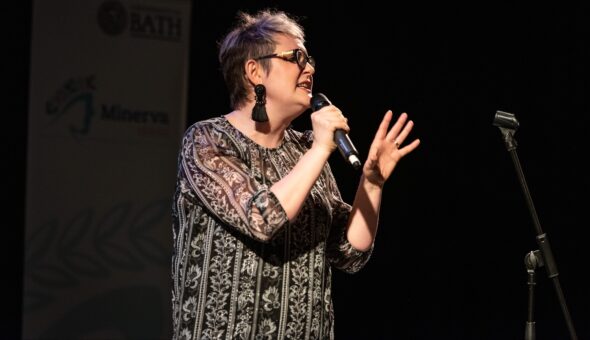Bailu Xie (Pharmacy & Pharmacology), Faye Monk (Pharmacy & Pharmacology) and Dr Paul De Bank (Pharmacy & Pharmacology) were awarded £500 to design and deliver two public engagement events to explain and promote the importance of modelling human pancreatic cancer, to two target audiences: primary school children and members of the public interested in science.
Bailu, Faye and Paul's first event was held at St. Mary’s Primary School as part of Bath Taps into Science. The aim was to engage children about the differences between cancer cells grown in 2D and 3D and how these related to finding alternative drug screening models for patients with pancreatic cancer to reduce animal use. To help the children to relate to these concepts, they used pictures and toys from the Disney Pixar movie “Inside Out”, where the characters were transformed from 3D to 2D. Fluffy pom-poms were used to help mimic cancer cells and capture the children’s interest. The team then showed the children how cells grown in 3D are different to the ones in 2D due to their multiple layers and how the barrier in the cancer tissue prevents anti-cancer drugs reaching every cancer cell. The children also learnt about how small a cell is, what a cell looks like and the plastic dish and plate where cells would grow in a laboratory. Bailu was surprised at her ability to keep the children engaged and interested in her research topic.

Some of the resources that Bailu used for her public engagement project
The second event was held at the University of Bath’s 50th Anniversary Festival on the 6th May. The aim here was to raise awareness about pancreatic cancer and talk to the general public about cancer research at the University of Bath, in collaboration with KOҪ University in Turkey. With support from her supervisor, Randy Mrsny, and with the help of a visiting pharmacist, Nour Abaza from Jordan, and a number of booklets and handouts from the charity, Pancreatic Cancer UK, Bailu was well-prepared for targeting all age groups. For the children, she adapted the same approach as the first event and also included a guessing game for them to find cells in the cancer model. For the adults, she gave them questionnaires about pancreatic cancer and then explained the answers and her PhD research project to help address the issues in pancreatic cancer. The questions covered areas such as the symptoms of pancreatic cancer, the 5-year survival rate of pancreatic cancer, the amount of UK investment in pancreatic cancer research, and the percentage of a pancreatic tumour that is made up of cancer cells.
Approximately 50-60 adults engaged in conversation with Bailu and 20 completed the questionnaires. According to the answers they gave, only 4 people were aware of all the symptoms of pancreatic cancer. The majority of participants knew the low survival rate of pancreatic cancer, but most of them were not aware that this is largely due to late diagnosis and the fact that little progress has been made in pancreatic cancer research compared to other cancer types. None of them knew that only about 10-20% of pancreatic cancer tissue is made up of cancer cells.
All the participants were fascinated by Bailu's project on modelling the microenvironment of late-stage human pancreatic cancer. Learning from other people’s personal experiences with cancer and their interest in wanting to know the scientific research behind it has encouraged Bailu to further pursue her career as a scientist in understanding pancreatic cancer and look for more opportunities to talk with the public about pancreatic cancer in the future.
Initially, the project aimed to engage A Level students, but the team struggled to gain access to a school within the timescale for their project. In future, the team's hope is to relate the students’ studies with the research going on at universities to prepare and inspire them for further education.
Contact Bailu (b.xie@bath.ac.uk) for further information about her project.
Responses


Please donate to the cancer charity if you can.
https://www.pancreaticcancer.org.uk/donate/
The following is more about less survivable cancers:
https://www.pancreaticcancer.org.uk/latest-news/2017/july/less-survivable-cancers-taskforce-launches-to-give-patients-a-fair-chance-of-survival/